Abstract
A hybrid material composed of guanine-rich single stranded DNA (G-rich ssDNA) and cobalt oxyhydroxide (CoOOH) nanosheets is used as a nanoprobe for fluorometric turn-on detection of ascorbic acid (AA). The CoOOH nanosheets function as a recognition component for AA. The G-rich ssDNA is used to produce a G-quadruplex, and the G-quadruplex/thioflavin T (ThT) complex acts as a fluorescent reporter. In the absence of AA, p-phenylenediamine (PPD) is oxidized to form oxPPD which has a dark red color. It causes the fluorescence of the G-quadruplex/ThT complex to be quenched. However, in the presence of AA, the CoOOH nanosheets of the nanoprobe are preferentially reduced by AA. Hence, PPD is not oxidized, and fluorescence is not quenched. A fluorometric turn-on method was developed based on these findings. It has a detection limit of 94 nM and works in the concentration range from 1 to 10 and 20 to 80 μM. This method was applied to the determination of AA in (spiked) fruit juice samples.

Schematic presentation of a fluorescent assay of ascorbic acid (AA) is established using a nanoprobe composed of guanine-rich single stranded DNA (G-rich ssDNA) and cobalt oxyhydroxide (CoOOH) nanosheets. It is based on competitive reduction of CoOOH by p-phenylenediamine (PPD) and AA. Thioflavine T (ThT) induces the formation of fluorescent G-quadruplex/ThT complex. The oxidized form of PPD (oxPPD) can quench the fluorescence via fluorescence resonance energy transfer (FRET), but AA suppresses quenching.





Similar content being viewed by others
References
Patil BS, Jayaprakasha GK, Chidambara Murthy KN, Vikram A (2009) Bioactive compounds: historical perspectives, opportunities, and challenges. J Agric Food Chem 57:8142–8160
Zhu X, Zhao T, Nie Z, Liu Y, Yao S (2015) Non-redox modulated fluorescence strategy for sensitive and selective ascorbic acid detection with highly photoluminescent nitrogen-doped carbon nanoparticles via solid-state synthesis. Anal Chem 87:8524–8530
Liu J, Chen Y, Wang W, Feng J, Liang M, Ma S, Chen X (2016) "Switch-on" fluorescent sensing of ascorbic acid in food samples based on carbon quantum dots-MnO2 probe. J Agric Food Chem 64:371–380
Arya SP, Mahajan M, Jain P (2000) Non-spectrophotometric methods for the determination of vitamin C. Anal Chim Acta 417:1–14
Cui W, Wang Y, Yang D, Du J (2017) Fluorometric determination of ascorbic acid by exploiting its deactivating effect on the oxidase–mimetic properties of cobalt oxyhydroxide nanosheets. Microchim Acta 184:4749–4755
Wang G, Chen Z, Chen L (2011) Mesoporous silica-coated gold nanorods: towards sensitive colorimetric sensing of ascorbic acid via target-induced silver overcoating. Nanoscale 3:1756–1759
Deng K, Li X, Huang H (2016) A glassy carbon electrode modified with a nickel(II) norcorrole complex and carbon nanotubes for simultaneous or individual determination of ascorbic acid, dopamine, and uric acid. Microchim Acta 183:2139–2145
Wang Z, Teng X, Lu C (2012) Carbonate interlayered hydrotalcites-enhanced peroxynitrous acid chemiluminescence for high selectivity sensing of ascorbic acid. Analyst 137:1876–1881
Frenich AG, Torres ME, Vega AB, Vidal JL, Bolanos PP (2005) Determination of ascorbic acid and carotenoids in food commodities by liquid chromatography with mass spectrometry detection. J Agric Food Chem 53:7371–7376
Zhao M, Yu H, He Y (2018) A dynamic multichannel colorimetric sensor array for highly effective discrimination of ten explosives. Sensors Actuators B Chem 283:329–333
Huang W, Zhou Y, Du J, Deng Y, He Y (2018) Versatile visual logic operations based on plasmonic switching in label-free molybdenum oxide nanomaterials. Anal Chem 90:2384–2388
Zhou Y, Huang W, He Y (2018) pH-Induced silver nanoprism etching-based multichannel colorimetric sensor array for ultrasensitive discrimination of thiols. Sensors Actuators B Chem 270:187–191
Ganiga M, Cyriac J (2016) An ascorbic acid sensor based on cadmium sulphide quantum dots. Anal Bioanal Chem 408:3699–3706
Li L, Wang C, Liu K, Wang Y, Liu K, Lin Y (2015) Hexagonal cobalt oxyhydroxide-carbon dots hybridized surface: high sensitive fluorescence turn-on probe for monitoring of ascorbic acid in rat brain following brain ischemia. Anal Chem 87:3404–3411
Meng H, Yang D, Tu Y, Yan J (2017) Turn-on fluorescence detection of ascorbic acid with gold nanolcusters. Talanta 165:346–350
Yue D, Zhao D, Zhang J, Zhang L, Jiang K, Zhang X, Cui Y, Yang Y, Chen B, Qian G (2017) A luminescent cerium metal-organic framework for the turn-on sensing of ascorbic acid. Chem Commun 53:11221–11224
Rong M, Lin L, Song X, Wang Y, Zhong Y, Yan J, Feng Y, Zeng X, Chen X (2015) Fluorescence sensing of chromium (VI) and ascorbic acid using graphitic carbon nitride nanosheets as a fluorescent “switch”. Biosens Bioelectron 68:210–217
Liu SG, Li N, Han L, Li LJ, Li NB, Luo HQ (2018) Size-dependent modulation of fluorescence and light scattering: a new strategy for development of ratiometric sensing. Mater Horiz 5:454–460
Sen D, Gilbert W (1988) Formation of parallel four-stranded complexes by guanine-rich motifs in DNA and its implications for meiosis. Nature 334:364–366
Zhao H, Dong J, Zhou F, Li B (2015) G-quadruplex − based homogenous fluorescence platform for ultrasensitive DNA detection through isothermal cycling and cascade signal amplification. Microchim Acta 182:2495–2502
Mohanty J, Barooah N, Dhamodharan V, Harikrishna S, Pradeepkumar PI, Bhasikuttan AC (2013) Thioflavin T as an efficient inducer and selective fluorescent sensor for the human telomeric G-quadruplex DNA. J Am Chem Soc 135:367–376
Du YC, Zhu LN, Kong DM (2016) Label-free thioflavin T/G-quadruplex-based real-time strand displacement amplification for biosensing applications. Biosens Bioelectron 86:811–817
Khusbu FY, Zhou X, Chen H, Ma C, Wang K (2018) Thioflavin T as a fluorescence probe for biosensing applications. Trends Anal Chem 109:1–18
Yang Y, Cen Y, Deng WJ, Yu RQ, Chen TT, Chu X (2016) An aptasensor based on cobalt oxyhydroxide nanosheets for the detection of thrombin. Anal Methods 8:7199–7203
Li N, Li Y, Han Y, Pan W, Zhang T, Tang B (2014) A highly selective and instantaneous nanoprobe for detection and imaging of ascorbic acid in living cells and in vivo. Anal Chem 86:3924–3930
Liu SG, Han L, Li N, Xiao N, Ju YJ, Li NB, Luo HQ (2018) A fluorescence and colorimetric dual-mode assay of alkaline phosphatase activity via destroying oxidase-like CoOOH nanoflakes. J Mater Chem B 6:2843–2850
Huang J, Shang Q, Huang Y, Tang F, Zhang Q, Liu Q, Jiang S, Hu F, Liu W, Luo Y, Yao T, Jiang Y, Pan Z, Sun Z, Wei S (2016) Oxyhydroxide nanosheets with highly efficient electron-hole pair separation for hydrogen evolution. Angew Chem Int Ed 55:2137–2141
Zhu L, Wu W, Zhu Y, Tang W, Wu Y (2015) Composite of CoOOH nanoplates with multiwalled carbon nanotubes as superior cathode material for supercapacitors. J Phys Chem C 119:7069–7075
Jiao K, Sun W, Zhang S, Sun G (2000) Application of p-phenylenediamine as an electrochemical substrate in peroxidase-mediated voltammetric enzyme immunoassay. Anal Chim Acta 413:71–78
Sun J, Zhao J, Wang L, Li H, Yang F, Yang X (2018) Inner filter effect-based sensor for horseradish peroxidase and its application to fluorescence immunoassay. ACS Sens 3:183–190
Chang Y, Zhang Z, Liu H, Wang N, Tang J (2016) Cobalt oxyhydroxide nanoflake based fluorescence sensing platform for label-free detection of DNA. Analyst 141:4719–4724
Li BL, Wang J, Zou HL, Garaj S, Lim CT, Xie J, Li NB, Leong DT (2016) Low-dimensional transition metal Dichalcogenide nanostructures based sensors. Adv Funct Mater 26:7034–7056
Zu F, Yan F, Bai Z, Xu J, Wang Y, Huang Y, Zhou X (2017) The quenching of the fluorescence of carbon dots: a review on mechanisms and applications. Microchim Acta 184:1899–1914
Liu SG, Luo D, Li N, Zhang W, Lei JL, Li NB, Luo HQ (2016) Water-soluble nonconjugated polymer nanoparticles with strong fluorescence emission for selective and sensitive detection of nitro-explosive picric acid in aqueous medium. ACS Appl Mater Interfaces 8:21700–21709
Raut S, Rich R, Fudala R, Butler S, Kokate R, Gryczynski Z, Luchowski R, Gryczynski I (2014) Resonance energy transfer between fluorescent BSA protected au nanoclusters and organic fluorophores. Nanoscale 6:385–391
Acknowledgments
Authors acknowledge financial support for this work from the National Natural Science Foundation of China (No. 21675131), the Natural Science Foundation of Chongqing (No. CSTC-2015jcyjB50001), and the Fundamental Research Funds for the Central Universities (XDJK2018D012).
Author information
Authors and Affiliations
Corresponding authors
Ethics declarations
The author(s) declare that they have no competing interests.
Additional information
Publisher’s note
Springer Nature remains neutral with regard to jurisdictional claims in published maps and institutional affiliations.
Electronic supplementary material
ESM 1
(DOC 3.33 mb)
Rights and permissions
About this article
Cite this article
Liu, S.G., Luo, D., Han, L. et al. A hybrid material composed of guanine-rich single stranded DNA and cobalt(III) oxyhydroxide (CoOOH) nanosheets as a fluorescent probe for ascorbic acid via formation of a complex between G-quadruplex and thioflavin T. Microchim Acta 186, 156 (2019). https://doi.org/10.1007/s00604-019-3279-y
Received:
Accepted:
Published:
DOI: https://doi.org/10.1007/s00604-019-3279-y




